Python を使用したデータ分析に関する簡単なチュートリアル
最近、プログラミングによる分析に Planet Python が追加されました。この Web サイトの最初のゲスト ブロガーの 1 人として、私はここで、Python を使用してデータ分析を開始する方法を共有します。具体的な内容は次のとおりです:
データのインポート ローカルまたは Web CSV ファイルのインポート
データの統計的説明
単一サンプル t テスト;
カスタム関数の作成
これは、その後の分析のために、まずデータをインポートする必要があります。一般的に、データは CSV 形式であり、そうでない場合でも、少なくとも CSV 形式に変換できます。 Python での操作は次のとおりです:
import pandas as pd # Reading data locally df = pd.read_csv('/Users/al-ahmadgaidasaad/Documents/d.csv') # Reading data from web data_url = "https://raw.githubusercontent.com/alstat/Analysis-with-Programming/master/2014/Python/Numerical-Descriptions-of-the-Data/data.csv" df = pd.read_csv(data_url)
ローカル CSV ファイルを読み取るには、pandas データ分析ライブラリに対応するモジュールが必要です。 read_csv 関数は、ローカル データと Web データを読み取ることができます。
データ変換
ワークスペースにデータが入ったので、次のステップはデータ変換です。統計学者や科学者は、このステップで分析から不要なデータを削除することがよくあります。まずデータを見てみましょう:
# Head of the data print df.head() # OUTPUT Abra Apayao Benguet Ifugao Kalinga 0 1243 2934 148 3300 10553 1 4158 9235 4287 8063 35257 2 1787 1922 1955 1074 4544 3 17152 14501 3536 19607 31687 4 1266 2385 2530 3315 8520 # Tail of the data print df.tail() # OUTPUT Abra Apayao Benguet Ifugao Kalinga 74 2505 20878 3519 19737 16513 75 60303 40065 7062 19422 61808 76 6311 6756 3561 15910 23349 77 13345 38902 2583 11096 68663 78 2623 18264 3745 16787 16900
R 言語プログラマにとって、上記の操作は、print(head(df)) を介してデータの最初の 6 行を出力し、print(tail(df) を介してデータを出力することと同等です。 ) 最後の6行。もちろん、Python ではデフォルトの印刷は 5 行ですが、R では 6 行です。したがって、R コードの head(df, n = 10) は Python では df.head(n = 10) となり、データの末尾の出力にも同じことが当てはまります。
R 言語では、データの列と行の名前はそれぞれ列名と行名を通じて抽出されます。 Python では、次のように列とインデックス属性を使用して抽出します。
# Extracting column names print df.columns # OUTPUT Index([u'Abra', u'Apayao', u'Benguet', u'Ifugao', u'Kalinga'], dtype='object') # Extracting row names or the index print df.index # OUTPUT Int64Index([0, 1, 2, 3, 4, 5, 6, 7, 8, 9, 10, 11, 12, 13, 14, 15, 16, 17, 18, 19, 20, 21, 22, 23, 24, 25, 26, 27, 28, 29, 30, 31, 32, 33, 34, 35, 36, 37, 38, 39, 40, 41, 42, 43, 44, 45, 46, 47, 48, 49, 50, 51, 52, 53, 54, 55, 56, 57, 58, 59, 60, 61, 62, 63, 64, 65, 66, 67, 68, 69, 70, 71, 72, 73, 74, 75, 76, 77, 78], dtype='int64')
データの転置には T メソッドが使用され、
# Transpose data print df.T # OUTPUT 0 1 2 3 4 5 6 7 8 9 Abra 1243 4158 1787 17152 1266 5576 927 21540 1039 5424 Apayao 2934 9235 1922 14501 2385 7452 1099 17038 1382 10588 Benguet 148 4287 1955 3536 2530 771 2796 2463 2592 1064 Ifugao 3300 8063 1074 19607 3315 13134 5134 14226 6842 13828 Kalinga 10553 35257 4544 31687 8520 28252 3106 36238 4973 40140 ... 69 70 71 72 73 74 75 76 77 Abra ... 12763 2470 59094 6209 13316 2505 60303 6311 13345 Apayao ... 37625 19532 35126 6335 38613 20878 40065 6756 38902 Benguet ... 2354 4045 5987 3530 2585 3519 7062 3561 2583 Ifugao ... 9838 17125 18940 15560 7746 19737 19422 15910 11096 Kalinga ... 65782 15279 52437 24385 66148 16513 61808 23349 68663 78 Abra 2623 Apayao 18264 Benguet 3745 Ifugao 16787 Kalinga 16900
並べ替えなどのその他の変換には sort 属性が使用されます。次に、データの特定の列を抽出します。 Python では、iloc または ix 属性を使用できます。ただし、私は ix の方が安定しているため、ix を使用することを好みます。データの最初の列の最初の 5 行が必要だとすると、次のようになります:
print df.ix[:, 0].head() # OUTPUT 0 1243 1 4158 2 1787 3 17152 4 1266 Name: Abra, dtype: int64
ちなみに、Python のインデックスは 1 ではなく 0 から始まります。行 11 から 20 までのデータの最初の 3 列を取得するには、次のようにします。
print df.ix[10:20, 0:3] # OUTPUT Abra Apayao Benguet 10 981 1311 2560 11 27366 15093 3039 12 1100 1701 2382 13 7212 11001 1088 14 1048 1427 2847 15 25679 15661 2942 16 1055 2191 2119 17 5437 6461 734 18 1029 1183 2302 19 23710 12222 2598 20 1091 2343 2654
上記のコマンドは、df.ix[10:20, ['Abra', 'Apayao', 'Benguet']] と同等です。
データ内の列を削除するには、列 1 (Apayao) と列 2 (Benguet) を示します。次のように、drop 属性を使用します:
print df.drop(df.columns[[1, 2]], axis = 1).head() # OUTPUT Abra Ifugao Kalinga 0 1243 3300 10553 1 4158 8063 35257 2 1787 1074 4544 3 17152 19607 31687 4 1266 3315 8520
axis パラメーターは、関数に列と行のどちらを削除するかを指示します。 axis が 0 の場合、行は破棄されます。
統計的記述
次のステップは、describe 属性を通じてデータの統計的特性を記述することです:
print df.describe()
# OUTPUT
Abra Apayao Benguet Ifugao Kalinga
count 79.000000 79.000000 79.000000 79.000000 79.000000
mean 12874.379747 16860.645570 3237.392405 12414.620253 30446.417722
std 16746.466945 15448.153794 1588.536429 5034.282019 22245.707692
min 927.000000 401.000000 148.000000 1074.000000 2346.000000
25% 1524.000000 3435.500000 2328.000000 8205.000000 8601.500000
50% 5790.000000 10588.000000 3202.000000 13044.000000 24494.000000
75% 13330.500000 33289.000000 3918.500000 16099.500000 52510.500000
max 60303.000000 54625.000000 8813.000000 21031.000000 68663.000000仮説テスト
Python には優れた統計推論パッケージがあります。それがscipyの統計です。 ttest_1samp は、単一サンプルの t 検定を実装します。したがって、帰無仮説を通過させて、データの Abra 列の米生産量の平均を検定したい場合、ここでは全体的な米生産量の平均が 15000 であると仮定します。次のようになります。
from scipy import stats as ss # Perform one sample t-test using 1500 as the true mean print ss.ttest_1samp(a = df.ix[:, 'Abra'], popmean = 15000) # OUTPUT (-1.1281738488299586, 0.26270472069109496)
以下で構成されるタプルを返します。値:
t : 浮動小数点または配列型
t 統計量prob : 浮動小数点または配列型
両側 p 値 両側確率値
上記の出力により、p 値が 0.267 であることがわかります。は 0.05 に等しい α よりもはるかに大きいため、コメの平均生産量が 150,000 ではないと言う十分な証拠はありません。この検定をすべての変数に適用し、再び平均を 15,000 と仮定すると、次のようになります:
print ss.ttest_1samp(a = df, popmean = 15000) # OUTPUT (array([ -1.12817385, 1.07053437, -65.81425599, -4.564575 , 6.17156198]), array([ 2.62704721e-01, 2.87680340e-01, 4.15643528e-70, 1.83764399e-05, 2.82461897e-08]))
最初の配列は t 統計量、2 番目の配列は対応する p 値です。 視覚化 Python には多くの視覚化モジュールがありますが、最も人気のあるものは matpalotlib ライブラリです。簡単に説明すると、Bokeh モジュールと Seaborn モジュールも選択できます。以前のブログ投稿で、matplotlib ライブラリの箱ひげ図モジュールの機能について説明しました。
# Import the module for plotting import matplotlib.pyplot as plt plt.show(df.plot(kind = 'box'))
import matplotlib.pyplot as plt pd.options.display.mpl_style = 'default' # Sets the plotting display theme to ggplot2 df.plot(kind = 'box')
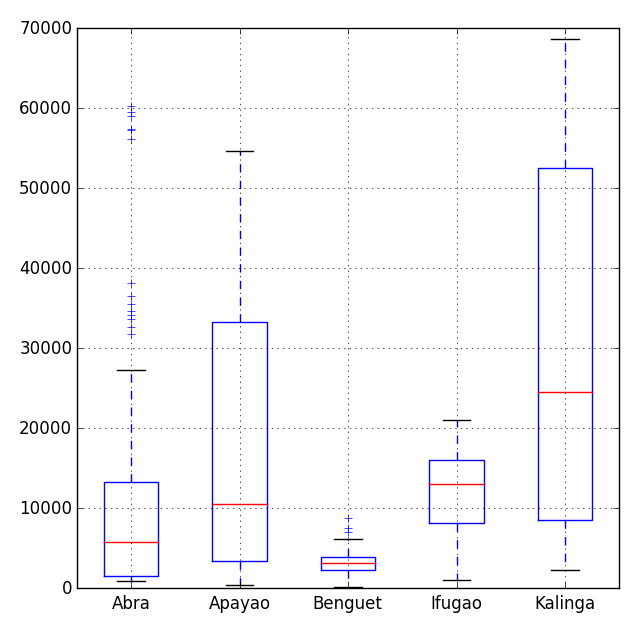 に 1 行追加するだけで、次のグラフが得られます: matplotlib.pyplot テーマよりもはるかに単純です。ただし、このブログ投稿では、統計データ視覚化ライブラリである seaborn モジュールを紹介したいと思います。
に 1 行追加するだけで、次のグラフが得られます: matplotlib.pyplot テーマよりもはるかに単純です。ただし、このブログ投稿では、統計データ視覚化ライブラリである seaborn モジュールを紹介したいと思います。 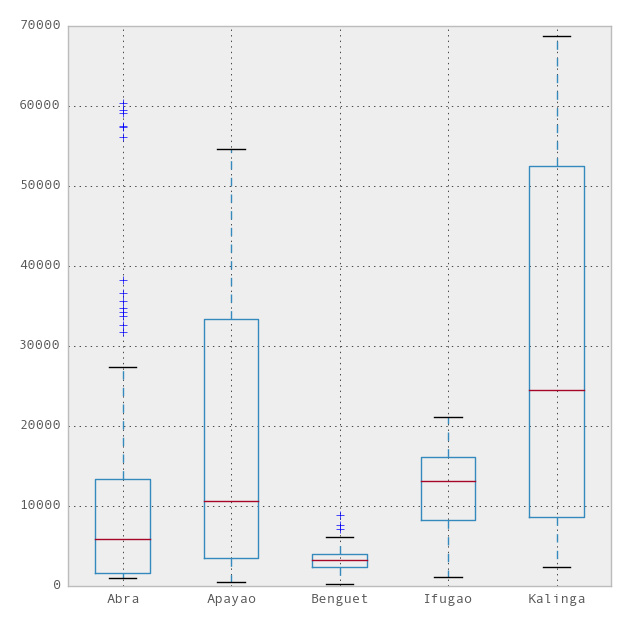
# Import the seaborn library import seaborn as sns # Do the boxplot plt.show(sns.boxplot(df, widths = 0.5, color = "pastel"))
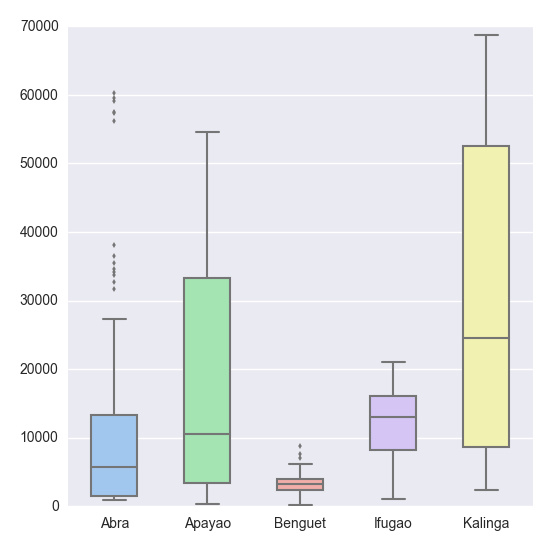
plt.show(sns.violinplot(df, widths = 0.5, color = "pastel"))
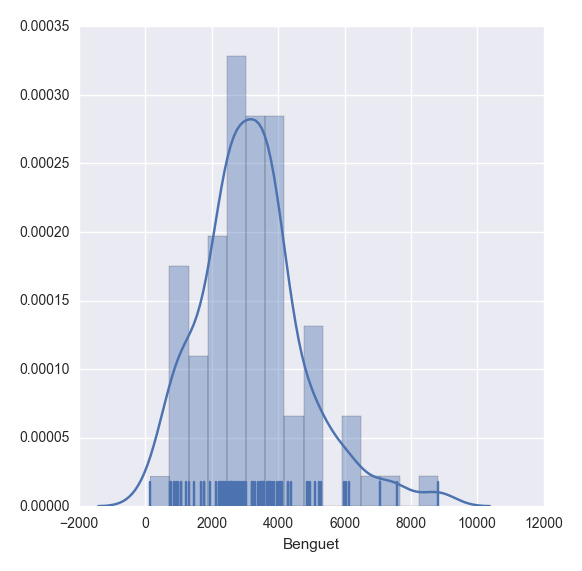
plt.show(sns.distplot(df.ix[:,2], rug = True, bins = 15))
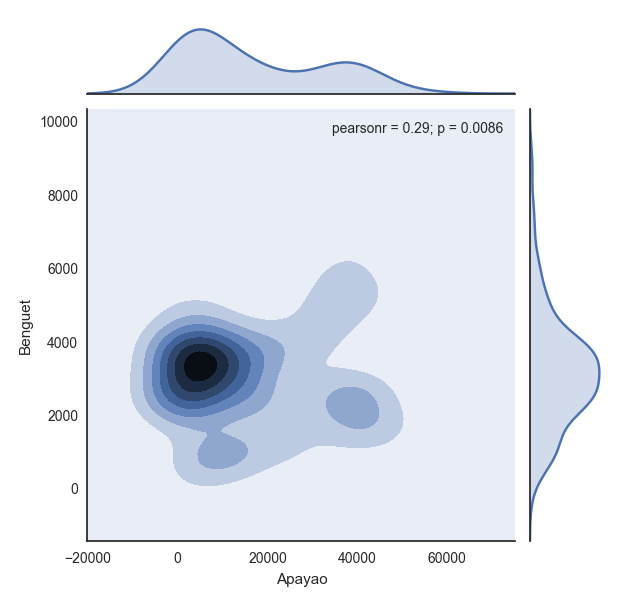
with sns.axes_style("white"):
plt.show(sns.jointplot(df.ix[:,1], df.ix[:,2], kind = "kde"))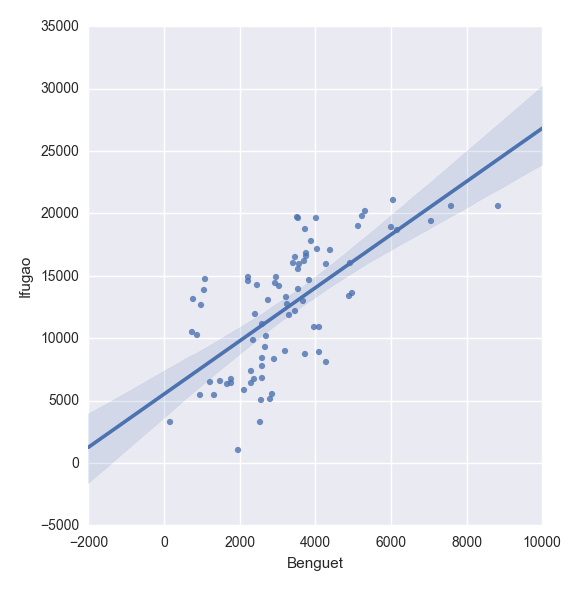
plt.show(sns.lmplot("Benguet", "Ifugao", df))创建自定义函数
在Python中,我们使用def函数来实现一个自定义函数。例如,如果我们要定义一个两数相加的函数,如下即可:
def add_2int(x, y): return x + y print add_2int(2, 2) # OUTPUT 4
顺便说一下,Python中的缩进是很重要的。通过缩进来定义函数作用域,就像在R语言中使用大括号{…}一样。这有一个我们之前博文的例子:
产生10个正态分布样本,其中u=3和o.
基于95%的置信度,计算 x_bar 和 x_bar2 ;
重复100次; 然后
计算出置信区间包含真实均值的百分比
Python中,程序如下:
import numpy as np
import scipy.stats as ss
def case(n = 10, mu = 3, sigma = np.sqrt(5), p = 0.025, rep = 100):
m = np.zeros((rep, 4))
for i in range(rep):
norm = np.random.normal(loc = mu, scale = sigma, size = n)
xbar = np.mean(norm)
low = xbar - ss.norm.ppf(q = 1 - p) * (sigma / np.sqrt(n))
up = xbar + ss.norm.ppf(q = 1 - p) * (sigma / np.sqrt(n))
if (mu > low) & (mu < up):
rem = 1
else:
rem = 0
m[i, :] = [xbar, low, up, rem]
inside = np.sum(m[:, 3])
per = inside / rep
desc = "There are " + str(inside) + " confidence intervals that contain "
"the true mean (" + str(mu) + "), that is " + str(per) + " percent of the total CIs"
return {"Matrix": m, "Decision": desc}
上述代码读起来很简单,但是循环的时候就很慢了。下面针对上述代码进行了改进,这多亏了 Python专家。
import numpy as np
import scipy.stats as ss
def case2(n = 10, mu = 3, sigma = np.sqrt(5), p = 0.025, rep = 100):
scaled_crit = ss.norm.ppf(q = 1 - p) * (sigma / np.sqrt(n))
norm = np.random.normal(loc = mu, scale = sigma, size = (rep, n))
xbar = norm.mean(1)
low = xbar - scaled_crit
up = xbar + scaled_crit
rem = (mu > low) & (mu < up)
m = np.c_[xbar, low, up, rem]
inside = np.sum(m[:, 3])
per = inside / rep
desc = "There are " + str(inside) + " confidence intervals that contain "
"the true mean (" + str(mu) + "), that is " + str(per) + " percent of the total CIs"
return {"Matrix": m, "Decision": desc}更多Python を使用したデータ分析に関する簡単なチュートリアル相关文章请关注PHP中文网!

ホットAIツール

Undresser.AI Undress
リアルなヌード写真を作成する AI 搭載アプリ

AI Clothes Remover
写真から衣服を削除するオンライン AI ツール。

Undress AI Tool
脱衣画像を無料で

Clothoff.io
AI衣類リムーバー

AI Hentai Generator
AIヘンタイを無料で生成します。

人気の記事

ホットツール

メモ帳++7.3.1
使いやすく無料のコードエディター

SublimeText3 中国語版
中国語版、とても使いやすい

ゼンドスタジオ 13.0.1
強力な PHP 統合開発環境

ドリームウィーバー CS6
ビジュアル Web 開発ツール

SublimeText3 Mac版
神レベルのコード編集ソフト(SublimeText3)

ホットトピック
 7491
7491
 15
15
 1377
1377
 52
52
 77
77
 11
11
 19
19
 41
41
 LinuxターミナルでPythonバージョンを表示するときに発生する権限の問題を解決する方法は?
Apr 01, 2025 pm 05:09 PM
LinuxターミナルでPythonバージョンを表示するときに発生する権限の問題を解決する方法は?
Apr 01, 2025 pm 05:09 PM
LinuxターミナルでPythonバージョンを表示する際の許可の問題の解決策PythonターミナルでPythonバージョンを表示しようとするとき、Pythonを入力してください...
 あるデータフレームの列全体を、Python内の異なる構造を持つ別のデータフレームに効率的にコピーする方法は?
Apr 01, 2025 pm 11:15 PM
あるデータフレームの列全体を、Python内の異なる構造を持つ別のデータフレームに効率的にコピーする方法は?
Apr 01, 2025 pm 11:15 PM
PythonのPandasライブラリを使用する場合、異なる構造を持つ2つのデータフレーム間で列全体をコピーする方法は一般的な問題です。 2つのデータがあるとします...
 プロジェクトの基本と問題駆動型の方法で10時間以内にコンピューター初心者プログラミングの基本を教える方法は?
Apr 02, 2025 am 07:18 AM
プロジェクトの基本と問題駆動型の方法で10時間以内にコンピューター初心者プログラミングの基本を教える方法は?
Apr 02, 2025 am 07:18 AM
10時間以内にコンピューター初心者プログラミングの基本を教える方法は?コンピューター初心者にプログラミングの知識を教えるのに10時間しかない場合、何を教えることを選びますか...
 uvicornは、serving_forever()なしでhttpリクエストをどのように継続的に聞いていますか?
Apr 01, 2025 pm 10:51 PM
uvicornは、serving_forever()なしでhttpリクエストをどのように継続的に聞いていますか?
Apr 01, 2025 pm 10:51 PM
UvicornはどのようにしてHTTPリクエストを継続的に聞きますか? Uvicornは、ASGIに基づく軽量のWebサーバーです。そのコア機能の1つは、HTTPリクエストを聞いて続行することです...
 文字列を介してオブジェクトを動的に作成し、Pythonでメソッドを呼び出す方法は?
Apr 01, 2025 pm 11:18 PM
文字列を介してオブジェクトを動的に作成し、Pythonでメソッドを呼び出す方法は?
Apr 01, 2025 pm 11:18 PM
Pythonでは、文字列を介してオブジェクトを動的に作成し、そのメソッドを呼び出す方法は?これは一般的なプログラミング要件です。特に構成または実行する必要がある場合は...
 人気のあるPythonライブラリとその用途は何ですか?
Mar 21, 2025 pm 06:46 PM
人気のあるPythonライブラリとその用途は何ですか?
Mar 21, 2025 pm 06:46 PM
この記事では、numpy、pandas、matplotlib、scikit-learn、tensorflow、django、flask、and requestsなどの人気のあるPythonライブラリについて説明し、科学的コンピューティング、データ分析、視覚化、機械学習、Web開発、Hの使用について説明します。
 中間の読書にどこでもfiddlerを使用するときにブラウザによって検出されないようにするにはどうすればよいですか?
Apr 02, 2025 am 07:15 AM
中間の読書にどこでもfiddlerを使用するときにブラウザによって検出されないようにするにはどうすればよいですか?
Apr 02, 2025 am 07:15 AM
fiddlereveryversings for the-middleの測定値を使用するときに検出されないようにする方法





